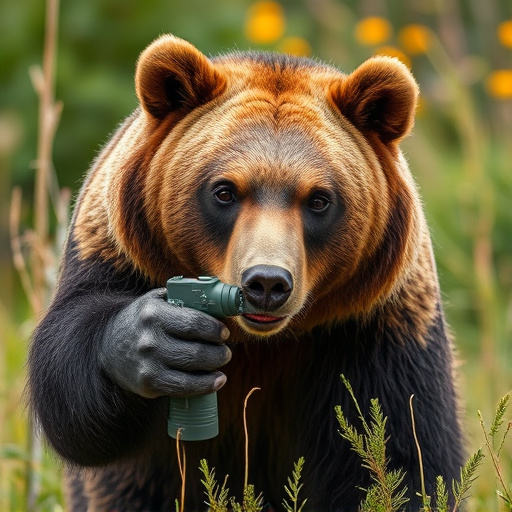Understanding bear behavior is key to using bear deterrent spray effectively. Optimal distance for spraying varies by species and conditions, typically 20-30 feet (6-9 meters) for black bears, up to 50-70 feet (15-21 meters) for grizzlies. Wind direction impacts effectiveness; spraying against the wind is best. Techniques include maintaining distance, steady streaming, covering all visible areas, and using larger canisters in rugged terrain. Follow legal guidelines, practice application, and use responsibly as a last resort during encounters.
“In areas where bears roam, knowing how to deter these majestic animals is crucial for safety. This article explores bear deterrent spray, focusing on its maximum range protection. We’ll delve into understanding bear behavior and the science behind spray efficacy. Key factors influencing the range of bear spray will be discussed, along with optimal application techniques. Additionally, we’ll cover legal considerations and essential safety guidelines for responsible use. Discover the ideal optimal distance for bear spray to ensure effective protection in unpredictable encounters.”
- Understanding Bear Behavior and Spray Efficacy
- Factors Influencing Bear Spray Range
- Optimal Application Techniques for Maximum Protection
- Legal Considerations and Safety Guidelines
Understanding Bear Behavior and Spray Efficacy
Understanding bear behavior is crucial when considering bear deterrent spray as a safety measure. Bears are naturally cautious animals, often avoiding human encounters altogether. However, they can become aggressive if surprised or feeling threatened, especially when protecting their cubs or food sources. The optimal distance for bear spray usage varies based on the species and circumstances. For black bears, the recommended range is typically between 20-30 feet (6-9 meters), as they tend to react with avoidance or retreat at this distance. Grizzly bears, being larger and more aggressive, may require spraying from a farther distance, around 50-70 feet (15-21 meters), to deter them effectively.
Bear deterrent spray is most effective when used at the optimal distance, creating a cloud of irritants in the bear’s path. The spray’s chemicals disrupt the animal’s senses, temporarily blinding and disorienting it, allowing you to retreat safely. It’s important to remember that wind direction plays a significant role; spraying into the wind can reduce the spray’s effectiveness, while spraying with the wind can carry the irritants back towards you. Therefore, understanding the bear’s behavior, choosing the right spray, and knowing the optimal distance for your specific situation are key to ensuring maximum protection when encountering bears in their natural habitat.
Factors Influencing Bear Spray Range
Several factors determine the range at which bear deterrent spray is effective, with the optimal distance varying based on these conditions. Wind speed and direction play a significant role; a headwind can carry the spray further, while a tailwind might reduce its reach. The terrain’s topography also matters; in open areas, spray can travel farther than in dense forests or rugged landscapes where it may be blocked or dissipated quickly.
Additionally, the type of bear deterrent spray and the size of the canister significantly impact the range. Commercially available bear spray typically has a recommended use distance of 20 to 30 feet (6 to 9 meters), but this can differ between brands and concentrations. Using a larger canister or one with higher concentration may extend the effective range, which is crucial for hikers and campers navigating areas known for bear activity.
Optimal Application Techniques for Maximum Protection
To achieve maximum protection from bear deterrent spray, it’s crucial to understand and employ optimal application techniques. One key aspect is maintaining the recommended optimal distance when spraying. Typically, this distance ranges from 20 to 30 feet (6 to 9 meters), ensuring that the spray reaches the bear while allowing for safe retreat. Incorrect application can result in missed targets or even worse, leaving you vulnerable if the spray doesn’t effectively deter the bear.
Remember that consistency is key; spray in a steady, even stream directly towards the bear’s face and body, covering all visible areas. The goal is to create an effective barrier of capsaicin, the active ingredient in bear spray, which temporarily blinds and irritates the bear, allowing you to safely move away. Practice these techniques before your next outdoor adventure to ensure confidence and maximize the protection offered by your bear deterrent spray.
Legal Considerations and Safety Guidelines
When considering bear deterrent spray, it’s crucial to understand legal considerations and safety guidelines that govern its use. Each jurisdiction has specific rules regarding the possession, carrying, and application of bear spray. It’s essential to familiarize yourself with local laws and regulations before purchasing or using any type of bear spray. This includes understanding the optimal distance for bear spray application, which typically ranges from 20 to 30 feet (6 to 9 meters), though this can vary based on factors like wind conditions and spray type.
Safety guidelines should always be followed rigorously. Bear spray is designed to deter bears by temporarily blinding them and irritating their nostrils, but it’s not a foolproof solution. It’s important to use bear spray responsibly, only as a last resort when facing an aggressive or unexpected bear encounter. Always keep your spray readily accessible, ensure the can is in good working order, and practice proper application techniques. Remember that safety comes first when navigating in bear country.
Bear deterrent spray offers a valuable tool for outdoor enthusiasts navigating bear country. Understanding bear behavior, the factors affecting spray range, and learning proper application techniques are key to ensuring maximum protection. By adhering to legal guidelines and safety protocols, individuals can effectively deter bears at an optimal distance of up to 20 feet, enhancing their overall outdoor experience.
